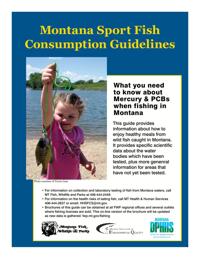Watch what you eat! Not all fish and game are up to snuff when consumed. Be a student of the health of any fish and game that you hope to add into your family’s diet. 
Fish, fowl, and game can be contaminated by many things. Some of these contaminants are the result of Nature while others are man-made. Pollution from development, mining, or human impact are always an issue. Natural pollution from geothermal features, siltation, flooding, and nature will change ecosystems.
You are what you eat! FWP regulations and guidelines offer suggestions and recommendations as to what and where fish and game may be a health issue. Diseases can be a concern. Big game may contain CWD or other parasites and issues that may be harmful if consumed. Knowledge is power when filling the pantry. 
The fish in Montana have many health concerns and consumption warnings. Mining has been the cause of toxins like mercury, arsenic, and lead being dumped into watersheds. Mercury was used by miners to coagulate fine particles of gold. A couple drops of mercury was added into a gold pan so the miners could collect the clumped gold fines. Excess mercury was spilled back into the watershed.
Natural pollution from Geysers, hot springs, and geothermal drainage finds its way into the watersheds. Most of Montana’s watersheds start in Yellowstone Park. Eating fish from the Yellowstone, Gallatin, and Madison Rivers are high in toxins.
There is good and bad news when talking about contaminated fish. Contamination in the Montana blue ribbon trout waters means excessive Catch and Release pressure. If anglers were also encouraged to keep and eat more trout, the fisheries could collapse.
Most anglers will not eat trout from contaminated waters. Fishermen can remove most locations of stored toxins in fish when cleaning them. This means fileting, skinning, trimming belly meat, removing meat at fin bases, and thorough rinsing.
To reduce any health risk…
Keep smaller fish for eating. Big fish live longer and absorb more toxins.
Eat smaller meals of fish and eat them less often.
Eat fish that are less likely to be contaminated. Mercury and PCBs are common in walleye and lake trout. It takes several years for these species to grow big enough to eat. Yellow perch and Rainbow trout tend to eat more plankton and have less contaminants and grow more quickly. . Brown trout feast on crustaceans like crayfish and tend to have more contaminants.
Clean and cook your catch thoroughly. Most contaminants are in the fatty portions. Cook fish using techniques that drain away the juices and fats. Air frying, baking, and smoking are good ideas. 
Check the Sport Consumption Guidelines at the MTFWP website for updates and warnings. Fwp.mt.gov/fwpDoc.html?id=28187. A fish icon with a fork and knife identifies consumption warnings.
Stocked fish tend to be healthier. These hatchery reared fish are tested regularly for any health or consumption concerns. It takes a stocked fish 3-6 months to absorb any contaminates.
Know what you are consuming before you put the fish into a creel, stringer, or ice chest.
Montana Grant